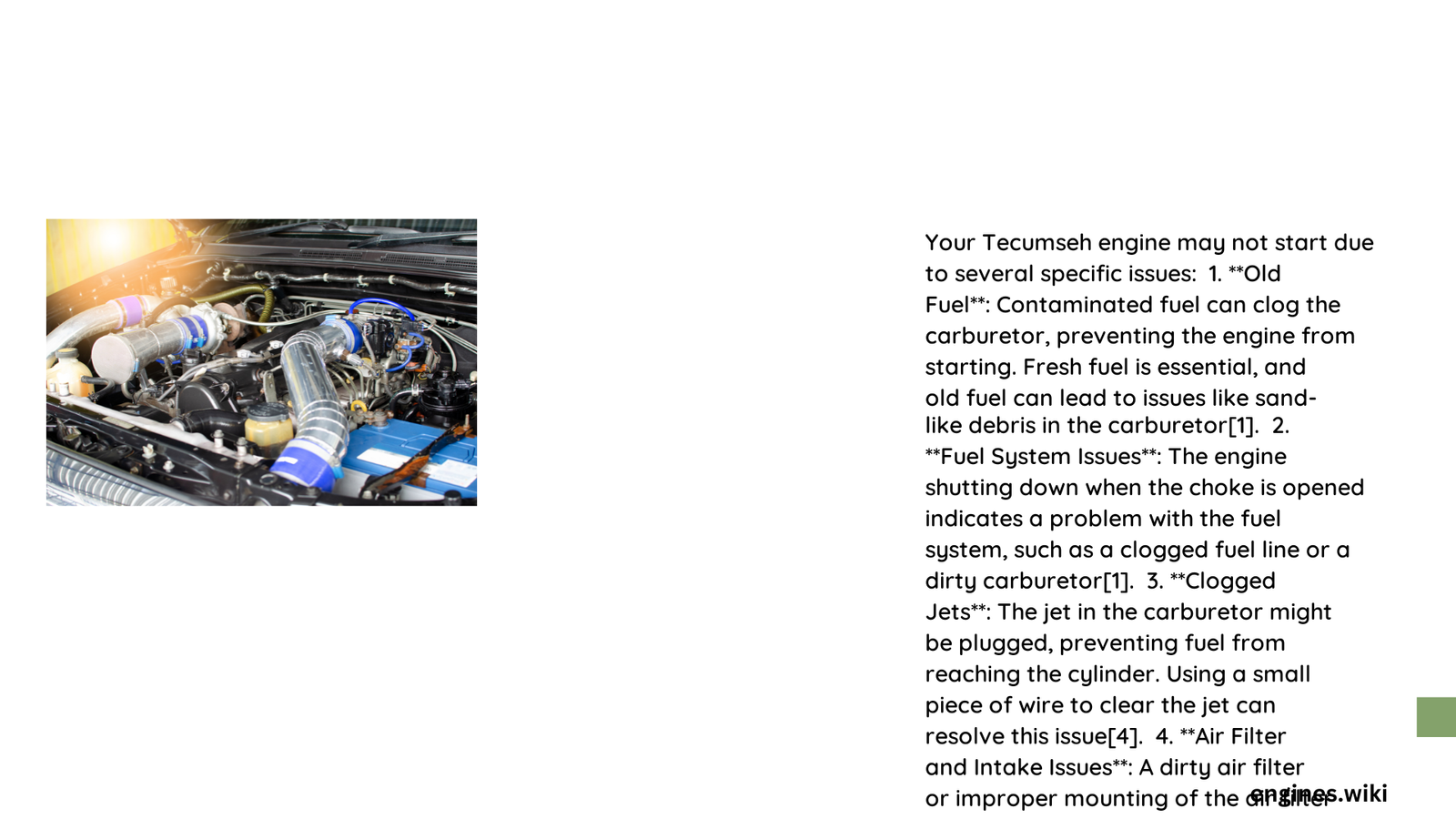When a Tecumseh engine refuses to start, it can be frustrating and potentially costly if not diagnosed correctly. Tecumseh engines commonly experience starting issues due to a combination of mechanical, fuel, and electrical system problems that prevent proper engine ignition. From clogged carburetors to faulty spark plugs, multiple factors can interrupt the engine’s startup process, requiring systematic diagnosis and targeted repairs.
What Causes Tecumseh Engine Starting Failures?
Fuel System Blockages
Fuel system problems are the most frequent culprits behind a non-starting Tecumseh engine. Key issues include:
| Problem | Symptoms | Potential Solution |
|---|---|---|
| Clogged Carburetor | Difficulty starting, sputtering | Clean or replace carburetor |
| Stale Fuel | Gummy residue, engine hesitation | Drain and replace fuel |
| Blocked Fuel Lines | No fuel flow | Clear or replace fuel lines |
How to Check Spark Delivery?
Spark delivery is crucial for engine ignition. To diagnose spark issues:
- Remove spark plug
- Reconnect spark plug wire
- Ground plug against engine block
- Crank engine and observe spark
- Look for strong, blue-white spark
Why Might Compression Be Low?
Low compression can prevent engine startup:
- Worn Piston Rings: Reduces sealing efficiency
- Damaged Cylinder Walls: Creates air leakage
- Valve Seal Deterioration: Prevents proper compression
Electrical System Diagnostics
What Signals Ignition Coil Failure?
- No spark during testing
- Intermittent engine performance
- Visual signs of electrical damage
- Resistance measurements outside specifications
Environmental Factors Affecting Start-Up
How Do Temperature Impact Engine Start?
- Cold Conditions:
- Use lighter weight oil
- Consider block heater
-
Utilize starting fluid cautiously
-
Hot Conditions:
- Ensure proper cooling
- Check for vapor lock
- Maintain adequate oil levels
Recommended Maintenance Practices
What Prevents Future Starting Problems?
- Regular fuel system cleaning
- Use fresh, stabilized fuel
- Replace spark plug annually
- Maintain proper oil levels
- Store engine in dry, temperature-controlled environment
Diagnostic Flowchart
[Engine Won't Start]
│
├── Check Fuel
│ ├── Fuel Present?
│ │ ├── Yes → Check Spark
│ │ └── No → Refuel/Check Fuel System
│
├── Check Spark
│ ├── Spark Present?
│ │ ├── Yes → Check Compression
│ │ └── No → Inspect Ignition System
│
└── Check Compression
├── Adequate Compression?
│ ├── Yes → Advanced Diagnostics
│ └── No → Engine Repair Needed
Professional Repair Considerations
When Should You Seek Professional Help?
- Persistent starting issues
- Complex electrical problems
- Low compression readings
- Lack of mechanical expertise
Cost-Effective Solutions
- DIY basic maintenance
- Use quality replacement parts
- Follow manufacturer’s guidelines
- Invest in diagnostic tools
Final Troubleshooting Tips
- Always disconnect spark plug wire before inspection
- Use proper safety equipment
- Consult Tecumseh engine manual
- Document diagnostic steps
Preventive Maintenance Checklist
- ✓ Clean air filter
- ✓ Replace spark plug
- ✓ Use fresh fuel
- ✓ Check oil levels
- ✓ Inspect fuel lines
- ✓ Store properly during off-season
Technical Specifications
- Recommended Fuel: Unleaded, 87 octane
- Oil Type: SAE 30 or 10W-30
- Spark Plug Gap: 0.028-0.030 inches

